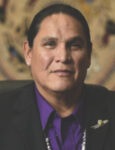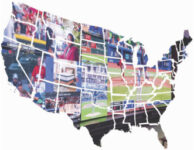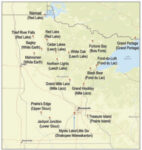
Businessman Standing at An Office Desk Smiling with One Hand in His Pocket --- Image by © Royalty-Free/Corbis
When Horizon Engineering Services was established 13 years ago in Tulsa, Oklahoma, the American Indian-owned civil engineering firm soon found a wealth of native clients in the emerging tribal government gambling industry.
“A lot of my initial success as a business person has been because of gaming,” says company President Margo Gray-Proctor, a citizen of the Osage Nation of Oklahoma. “Horizon Engineering has done, perhaps, 20 casinos, from the smallest to the resorts. We continue to do work on tribal casinos even today.”
Horizon’s project list also includes housing, hospitals and airports for tribal and non-Indian clients. Gray-Proctor expanded Horizon’s business umbrella to include drug screening and entertainment subsidiaries to meet the needs of the tribal gambling and resort industry.
U.S. Census figures show a 17.9 percent growth in American Indian-owned businesses from 2002 to 2007, an explosion of tribal entrepreneurialism that generates some $27 billion in combined sales. The figure roughly equals revenue from the nation’s 446 tribal casinos in 28 states.
Gaming Good for Native Business
While there is no empirical data to show a link between Native American business growth and the emergence of tribal gambling, tribal leaders and financial consultants believe the development of tribal casinos, many with hotels, are helping fuel a rise in native entrepreneurs.
“I would think gaming has probably had a tremendous role in the growth of native-owned businesses,” says Tracy Stanhoff, a member of the Prairie Band Potawatomi Nation of Kansas and owner of Ad Pro, an advertising and graphic design company based in Huntington Beach, California. About 30 percent of Ad Pro business is with American Indian clients.
It was the congressional intent of the Indian Gaming Regulatory Act of 1988 to strengthen tribal governments and grow diversified tribal economies. That goal has been at least partially achieved with the more than 227,000 American Indians and Alaska Natives who, according to a 2007 census report, are either self-employed or own businesses with employees.
A federal policy of tribal self-determination launched in the 1970s, a gradual strengthening of Indian self-governance and revenue from casino gambling has led to economic and social progress in Indian country.
But tribal leaders who hoped IGRA and the emerging tribal gambling, resort and tourism industry would fuel a return to the native economy and intertribal trade that existed before European settlement of North America are less than satisfied.
Many of the 565 Indian governments and Alaska native villages and corporations have policies and ordinances with native preference in hiring and contracting services. “I don’t know of any tribe in Oklahoma (a state with 39 federally recognized tribes) that doesn’t have tribal preference in hiring and contracting,” says Jess Green, a Chickasaw attorney.
The Cherokee Nation of Oklahoma, which has a well-established government and diversified economy, is heralded for its procurement policy, small business loan program and other efforts to encourage native entrepreneurialism.
“The Cherokee Tribe of Oklahoma is the gold standard in working with tribally owned businesses,” Gray-Protor says. “I have yet to find a better process—their bid process and their advocating for native-owned businesses. They want tribal members to grow their community.”
Better Buy
But the “buy Indian” concept—illustrated by tribal casino resorts and other tribal government business enterprises using tribal-owned vendors—has been slow to become a reality. Tribal leaders contend there have been too few tribal business partnerships and joint ventures involving native entrepreneurs and tribal government enterprises.
“Native partnerships are ideal, whether it involves small, tribally owned businesses or tribal government business enterprises. That’s always encouraged,” says Gray-Proctor, chairwoman for the National Center for American Indian Enterprise Development. “But it has to be the right fit. You just can’t do it because it needs to be done. It has to be the right opportunity.
“We are seeing those types of tribal partnerships. But is it occurring as often and as fast as we want it to? No. A 17 percent growth in tribal businesses is a great start. Is it enough? No.”
“I don’t think there’s enough native-to-native business,” agrees Stanhoff, head of the American Indian Chamber of Commerce of California, “but we’re making strides in doing more of that.”
The American Indian Business Network formed several years ago by the National Indian Gaming Association to foster tribal business partnerships and joint ventures has yet to deliver on its promises. Management of the network was recently placed in the hands of Jamie Fullmer, former chairman of the Yavapai Apache Nation and CEO of Blue Stone Strategy Group, a Phoenix, Arizona, tribal consulting firm.
“Our challenge is the concern that tribes aren’t using native-owned businesses,” Fullmer says. “That might not necessarily be because they don’t want to, but rather because there isn’t a national communication infrastructure by which tribes that want and need vendor services can connect to tribally owned and native-owned service providers or product producers.”
The Intertribal Agricultural Council (IAC) has failed in its effort to work with NIGA tribes on a cooperative agreement to sell beef, poultry and crops produced on reservation farms and ranches to tribal gambling resorts.
“It isn’t taking place,” says Nathan Notah, program manager for the IAC and a citizen of the Navajo Nation. “There are different tribal groups and individuals who are attempting to work together with gaming tribes, but so far it hasn’t happened.”
The market value of crops and food products produced on tribal lands in 2007 reached $2.2 billion, according to the U.S. Department of Agriculture. About $286.3 million came from ranches and farms owned by individual American Indians and Alaska Natives. Other reservation farms and ranches are operated by tribal governments or non-Indians. There were 79,703 native-owned farm and ranch operations in 2007, according to the Department of Agriculture, an increase of 88 percent from 2002.
“Most tribes are working with regional buyers and distributors for their products,” Notah says. “But as with any business you are always looking for new prospects. That’s what the gaming industry would be.”
Meanwhile, the National Indian Gaming Commission, the federal agency that oversees tribal casinos, is considering including a “buy Indian” provision as part of its ongoing review of NIGC regulations.
Tribal Partnerships
One of the most prominent gambling-related tribal partnerships is the 2005 union of the San Manuel Band of Mission Indians and Viejas Band of Kumeyaay Indians, both of Southern California, and the Oneida Nation and Forest County Potawatomi of Wisconsin in Four Fires LLC, developers of a Marriott Residence Inn Hotel in Washington, D.C. San Manuel, Viejas and Oneida later formed Three Fires LLC, developers of a second Marriott Residence Inn in Sacramento, California.
“It would be very much an understatement to describe Four Fires and Three Fires as merely two LLCs joining tribes and non-Indian corporations together in the development of hotels,” Viejas Chairman Anthony Pico said in 2005. “It was our hope that by creating a model for tribal partnerships in joint ventures Viejas could promote economic diversity and the growth of a nationwide tribal economy.”
The growth of a diversified nationwide tribal economy is slowly becoming a reality, in part because of the reinvestment of revenue from tribal casinos. But tribal partnerships similar to Four Fires and Three Fires remain elusive.
“I haven’t seen a tribal partnership constructed in that way since then,” says Bill Lomax, president of the Native American Finance Officers Association.
Indian communities with casinos have reached out to other tribes in economic development projects. The Yavapai Apaches under Fullmer’s leadership assisted four Indian tribes in financing and managing casinos. The Pequot Indian Nation, Mohegan Tribe and others have also assisted in financing of tribal casinos.
The Shakopee Mdewakanton Sioux Community, owners of the lucrative Mystic Lakes Casino in Prior Lake, Minnesota, has in the last 13 years contributed an astonishing $200 million to charities and Indian organizations, including grants of $1 million or more to several tribes for economic development projects.
“Our philosophy was that we wanted to help tribes get through difficult times or raise money to start or expand businesses,” Chairman Stanley Crooks of the Shakopee Sioux says of the tribe’s charitable giving to other Indian nations. “We didn’t want to do some joint venture and share in the profits, but we wanted to make it easier for them to get money they needed to do what they thought was right for their tribe, whether it’s economic development or job creation.”
Change Is Coming
It has been three or four decades since most tribes began rebuilding communities decimated by centuries of genocide, poverty and a failed system of federal government paternalism. Native financial experts note a disparity in the maturity of tribal governments, legal systems and economies that make intertribal partnerships difficult. Government gambling, they say, is only a partial solution.
“Given there had been several generations of poverty and failed government policies toward American Indians, it’s premature to take a 1988 decision like the Indian Gaming Regulatory Act and ask, ‘Is it working?’” says Mike Lettig, an executive with KeyBank’s Native American Financial Services. “A fair observation would be, ‘It’s a start.’”
Tribal government gambling has largely benefited a few, smaller tribes in urban areas of the country. In 2009 about 29 percent of the 446 tribal casinos generated 87 percent of the country’s tribal casino revenues, according to Alan Meister, an economist with Nathan Associates Inc. and author of the 2011 edition of the Indian Gaming Industry Report. Many large, remote tribes in the Midwest, Great Plains and Southwest remain locked in cyclical poverty.
“IGRA is one effort that has had a small impact on the great economic needs of Native America,” Lettig says. “The infrastructure needs of Native America today—water, sewer, roads, housing—have been estimated at between $50 billion and $60 billion. In terms of addressing the needs and issues in Pine Ridge and Rosebud, Hopi and San Carlos, the issues of inadequate housing and third-world conditions have not been rectified.”
“The economic viability and business logic behind tribal government gaming don’t fit every tribe. There’s an economic mismatch at this juncture,” Lettig continues. “Native America remains a third-world country in the world’s most prosperous nation. Over the next several years you will see strategic alliances. It just takes time.”
Indian communities need to separate tribal governance from business and economic development, Gray-Proctor says. She and Lomax also believe gaming tribes need to diversity economies that today are heavily dependent on casinos to generate government revenues.
“In terms of true diversification from a business and finance perspective, most tribes are not diversifying away from gaming, at least in a way I as a business person think that they should,” Lomax says.
“Tribes rightfully have been looking at the whole issue of economic development, trying to spur activity on their own reservations,” says Jacob Coin, executive of public affairs for the San Manuel Band of Serrano Mission Indians in San Bernardino County, California. “I would like to see tribes do more to use their governmental, sovereign powers to create a political and economic climate within their jurisdictions to stimulate the kind of individual entrepreneurialism and private-sector development that we desperately need.
“The Three Fires, Four Fires model is one whose day is here. Tribes should look at creating these kinds of alliances and partnerships and trying to work through the challenges of opening up their economic outreach beyond reservation boundaries. The whole world is our market. The whole world is our economy. We need to be a part of that.”
















